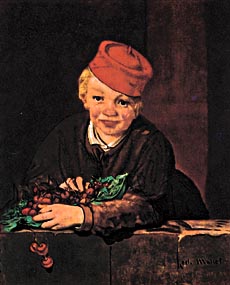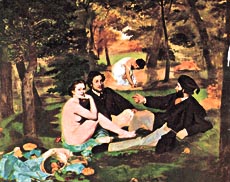










 








 

 |
Words and
pigments
Art
By Vijayan
Kannampilly
A POET’S coins are words and
his prize is sound — rhyme and rhythm, metre and
cadence. A painter’s coins are colour and his prize
is silence — line and form, form and composition.
Yet, within the sound and the silence there is a
revelation, a secret knowledge which comes through
contemplation, and once learnt will not disappear. It is
this core of meaning arrived at through vastly different
means which makes the twin arts companions in a common
search.
 The personal histories of this
companionship are well known Mallarme, for instance, was
a daily visitor at the studio of Degas, and Rilke served
for sometime as the secretary of Rodin. The personal histories of this
companionship are well known Mallarme, for instance, was
a daily visitor at the studio of Degas, and Rilke served
for sometime as the secretary of Rodin.
In the modern period we
have the close relationships which Apollinaire, Eluard,
Aragon and Reverdy shared with Picasso, Matisse and
Braque, or Lorca with Dali.
We also have examples of
poets who were also painters and vice versa. In India, an
example which springs to mind is Gulam Mohammad Sheikh.
In the West we have Blake and in more recent times
Cummings. These examples are of course only illustrative.
Painters have also used their creativity to illustrate
the works of poets. Picasso’s enormous output on
this score and Hockney’s work on Cavafy’s poems
are some cases in point. The reverse has also happened.
The late Ted Hughes wrote his poem Crow to
accompany an edition of Leonard Baskin’s crow
engravings.
As opposed to this jugalbandi
of sorts the history of the two arts also has another
tradition not confined only to companionship and
collaboration, but to comment as Paz did on Duchamp. By
virtue of the fact that without words one cannot comment
it is natural that in this area the poet is the
commentator. Though painters could tend to see their
illustrations as comments, more often than not the
illustrations to succeed have to be as directly related
to the verses as possible; painters picturise the poetry,
they do not comment on it often.
 A
poet’s comments on paintings could of course be a
piece of art criticism, and many poets have been art
critics. For instance, in Delhi Keshav Mallik and Prayag
Shukla are two names which come immediately to mind.
However, when a poet approaches paintings as a subject
and not as a personal response to a painter’s works
or an exhibition, then we have the poet on painting. In
India, as far as I know, the poets who have embarked upon
this is Prayag Shukla and Vinod Bharadwaj in Hindi and K
Satchidanandan in Malayalam, with Shukla also having
curated ‘Drawing 94’ for Gallerie Espace. Yet,
when all is said and done this tradition of one art,
poetry, trying to explore and understand another art,
painting, is not an old one in India. One reason is that
painting unlike poetry is a recent entrant into the
fellowship of ‘fine’ arts in this country. A
major reason for this late acceptance is the fact that in
a caste-stratified society where dignity of labour does
not exist, any manual art despite tracing its practice to
time-honoured treatises is not easily deemed worthy of
this honour. A
poet’s comments on paintings could of course be a
piece of art criticism, and many poets have been art
critics. For instance, in Delhi Keshav Mallik and Prayag
Shukla are two names which come immediately to mind.
However, when a poet approaches paintings as a subject
and not as a personal response to a painter’s works
or an exhibition, then we have the poet on painting. In
India, as far as I know, the poets who have embarked upon
this is Prayag Shukla and Vinod Bharadwaj in Hindi and K
Satchidanandan in Malayalam, with Shukla also having
curated ‘Drawing 94’ for Gallerie Espace. Yet,
when all is said and done this tradition of one art,
poetry, trying to explore and understand another art,
painting, is not an old one in India. One reason is that
painting unlike poetry is a recent entrant into the
fellowship of ‘fine’ arts in this country. A
major reason for this late acceptance is the fact that in
a caste-stratified society where dignity of labour does
not exist, any manual art despite tracing its practice to
time-honoured treatises is not easily deemed worthy of
this honour.
What attracts a poet to
painting? Stephen Spender set out to answer this in an
essay published in 1962. Spender was eminently qualified
for this task because, besides being a poet of repute, he
was also a student of painting under William Coldstream,
professor at Slade School. In his essay, Spender makes
the crucial point that "apart from (having) the
organising power of the visual imagination (painters),
observe what Blake called ‘minute particulars’.
They create images and they store memories."
The creation of images,
the act of image - making, is what unites the craft of
the poet to that of the painter. The means are of course
different. One uses words; the other pigments. But
painters have also seen their craft and its art
differently. Thus Van Gogh writes in a letter: "The
strokes come with a sequence and coherence like words in
a speech or letter." Matisse speaks of the harmony
of colors as a "harmony analogous to that of a
musical composition." It is probably this sound
within the silence of a painting which enthrals the poet,
while the imagery of the poet, real and tangible but
expressed through the most abstract of human inventions,
the word is what draws the painter to poetry. The two
worlds are different and yet similar... and so very
familiar. 
|

